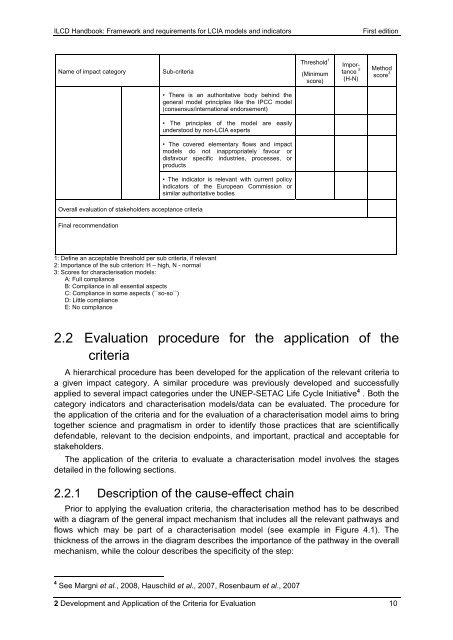ILCD Handbook: Framework and requirements for LCIA models and ...
ILCD Handbook: Framework and requirements for LCIA models and ...
ILCD Handbook: Framework and requirements for LCIA models and ...
You also want an ePaper? Increase the reach of your titles
YUMPU automatically turns print PDFs into web optimized ePapers that Google loves.
<strong>ILCD</strong> <strong>H<strong>and</strong>book</strong>: <strong>Framework</strong> <strong>and</strong> <strong>requirements</strong> <strong>for</strong> <strong>LCIA</strong> <strong>models</strong> <strong>and</strong> indicators First edition<br />
Name of impact category Sub-criteria<br />
Overall evaluation of stakeholders acceptance criteria<br />
Final recommendation<br />
1: Define an acceptable threshold per sub criteria, if relevant<br />
2: Importance of the sub criterion: H – high, N - normal<br />
3: Scores <strong>for</strong> characterisation <strong>models</strong>:<br />
A: Full compliance<br />
B: Compliance in all essential aspects<br />
C: Compliance in some aspects (``so-so``)<br />
D: Little compliance<br />
E: No compliance<br />
• There is an authoritative body behind the<br />
general model principles like the IPCC model<br />
(consensus/international endorsement)<br />
• The principles of the model are easily<br />
understood by non-<strong>LCIA</strong> experts<br />
• The covered elementary flows <strong>and</strong> impact<br />
<strong>models</strong> do not inappropriately favour or<br />
disfavour specific industries, processes, or<br />
products<br />
• The indicator is relevant with current policy<br />
indicators of the European Commission or<br />
similar authoritative bodies<br />
Threshold 1<br />
(Minimum<br />
score)<br />
Importance<br />
2<br />
(H-N)<br />
Method<br />
score 3<br />
2.2 Evaluation procedure <strong>for</strong> the application of the<br />
criteria<br />
A hierarchical procedure has been developed <strong>for</strong> the application of the relevant criteria to<br />
a given impact category. A similar procedure was previously developed <strong>and</strong> successfully<br />
applied to several impact categories under the UNEP-SETAC Life Cycle Initiative 4 . Both the<br />
category indicators <strong>and</strong> characterisation <strong>models</strong>/data can be evaluated. The procedure <strong>for</strong><br />
the application of the criteria <strong>and</strong> <strong>for</strong> the evaluation of a characterisation model aims to bring<br />
together science <strong>and</strong> pragmatism in order to identify those practices that are scientifically<br />
defendable, relevant to the decision endpoints, <strong>and</strong> important, practical <strong>and</strong> acceptable <strong>for</strong><br />
stakeholders.<br />
The application of the criteria to evaluate a characterisation model involves the stages<br />
detailed in the following sections.<br />
2.2.1 Description of the cause-effect chain<br />
Prior to applying the evaluation criteria, the characterisation method has to be described<br />
with a diagram of the general impact mechanism that includes all the relevant pathways <strong>and</strong><br />
flows which may be part of a characterisation model (see example in Figure 4.1). The<br />
thickness of the arrows in the diagram describes the importance of the pathway in the overall<br />
mechanism, while the colour describes the specificity of the step:<br />
4 See Margni et al., 2008, Hauschild et al., 2007, Rosenbaum et al., 2007<br />
2 Development <strong>and</strong> Application of the Criteria <strong>for</strong> Evaluation 10



